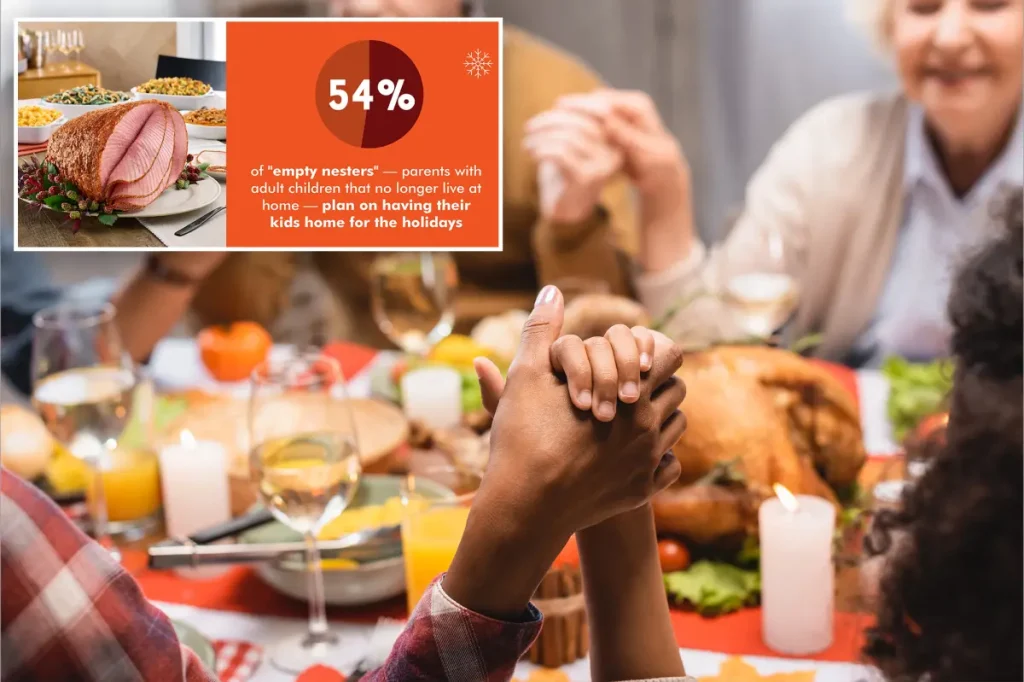The Heartwarming Pull of Home-Cooked Meals for Empty Nesters During the Holidays
As the holiday season approaches, empty nesters across America are preparing their homes for the return of their adult children. According to a recent survey commissioned by The Honey Baked Ham Company, more than half (54%) of parents whose children have moved out expect to welcome them home for the holidays this year. These reunions aren’t just casual visits—adult children are traveling an average of 596 miles to return to their childhood homes. For many parents, the empty nest syndrome brings challenges: 36% struggle with the quietness of their homes, while 35% find themselves nostalgic for the days when their children were younger. Despite the distance and time apart, 69% of empty nesters report it’s “easy” to convince their adult children to come home for the holidays. The secret weapon in this homecoming persuasion? Food—specifically, the comfort of familiar family recipes and holiday traditions that create an irresistible pull toward home.
The survey reveals a touching dynamic between adult children and their parents. About 28% of adult children make specific requests for their homecoming visits, with 72% asking for their favorite meals to be prepared, 46% requesting their preferred snacks and drinks, and 18% wanting to visit local hangouts from their younger days. Empty nesters are overwhelmingly willing to accommodate these requests, with 87% already planning to prepare their children’s favorite meals during their holiday visits. The ways parents entice their children home vary: 26% remind their kids how nice it would be to visit, 19% specifically promise to welcome them with their favorite foods, and 16% offer to send them home with leftovers and extras. These strategies reflect how food has become not just sustenance, but a language of love and connection between generations—a tangible reminder of care that spans distance and time.
The preparation for these family reunions begins well before the actual holidays arrive. Two-thirds of empty nesters start shopping weeks in advance to ensure they have all their children’s favorite foods ready. This advanced planning becomes even more complex when considering additional guests, with 42% of parents acknowledging they’ll need to shop for different foods depending on who their children bring home with them. Jim Dinkins, CEO of HoneyBaked, observes that “Making the home really feel like home means making sure there’s something for everybody. Around the holidays, people want to feel welcomed. There is nothing quite as welcoming as making sure their favorite foods are ready for them.” This sentiment captures the essence of holiday hosting for empty nesters—creating a space where everyone feels acknowledged through the universal language of favorite foods.
The holiday table at empty nesters’ homes is increasingly diverse, reflecting the expanding family circles that gather during these special times. Beyond their adult children, empty nesters are preparing to welcome grandchildren (53%), their children’s significant others (42%), extended family members (40%), and their own partners (36%). With such varied guests, four in five empty nesters believe it’s important that everyone has something good to eat, regardless of their preferences. On average, they plan to prepare three different main dishes before guests arrive, with turkey (66%) and ham (52%) being the most popular choices. This diversity of offerings shows how the holiday meal has evolved from a traditional single-dish centerpiece to a more inclusive spread that accommodates various tastes, dietary restrictions, and cultural influences—all while maintaining the warmth of family tradition.
Despite careful planning, holiday hosting comes with its share of last-minute adjustments. More than half (56%) of empty nesters anticipate making last-minute runs to the store for forgotten items, with one in four expecting to make at least two such trips. These statistics highlight the reality behind the seemingly effortless holiday gatherings—they require significant planning, adaptation, and sometimes a bit of improvisation. As Dinkins notes, “Food is such an important part of the holidays—it’s exactly what empty nesters and their kids can gather around to make coming home for the holidays feel special. But empty nesters don’t want to spend all their time in the kitchen, away from the family members they only see once or twice a year. They deserve to have recipes and meal options that are effortless yet delicious, letting them put more focus on spending time with family.” This observation captures the delicate balance empty nesters strive to achieve—creating memorable meals without sacrificing precious moments with loved ones.
The survey, which included 1,000 American parents with adult children living away from home, illuminates how food serves as the centerpiece of holiday reunions. Beyond mere tradition, these carefully prepared meals represent a continuation of family bonds across generations and changing life circumstances. For empty nesters, preparing a child’s favorite dish is more than cooking—it’s a way to say “I remember you” and “You still belong here.” For adult children, returning to a home filled with familiar aromas and tastes provides comfort and connection in an increasingly mobile world. As families gather around tables this holiday season, they’re not just sharing meals but reinforcing the enduring ties that define family life, proving that even as nests empty and children build lives elsewhere, the pull of home—especially when accompanied by the scent of favorite recipes—remains powerful and meaningful. These holiday gatherings, centered around lovingly prepared food, create memories that sustain both parents and children through the distances that separate them throughout the year.














